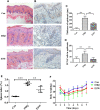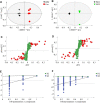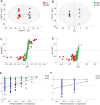Pithecellobium clypearia: Amelioration Effect on Imiquimod-Induced Psoriasis in Mice Based on a Tissue Metabonomic Analysis
- PMID: 34603060
- PMCID: PMC8484644
- DOI: 10.3389/fphar.2021.748772
Pithecellobium clypearia: Amelioration Effect on Imiquimod-Induced Psoriasis in Mice Based on a Tissue Metabonomic Analysis
Abstract
Pithecellobium clypearia Benth. (accepted name: Archidendron clypearia (Jack) I.C.Nielsen; Mimosaceae), a popular traditional Chinese medicine, has a significant anti-inflammatory effect. The crude water extract of the aerial part of P. clypearia has been clinically applied to treat upper respiratory tract infections, acute gastroenteritis, laryngitis, and pharyngitis. However, the therapeutic mechanism of ethanol fraction of water extract (ESW) of P. clypearia to treat psoriasis should be complemented. The aim of our research was to clarify the protective effects of ESW from P. clypearia against psoriasis-like skin inflammation induced by imiquimod (IMQ) in mice with efficacy indexes and target tissue (spleen and serum) metabolomics. The ingredient of ESW was analyzed by ultrahigh-performance liquid chromatography combined with tandem mass spectrometry (UHPLC-MS/MS) method. The imiquimod-induced psoriatic mouse model was employed to investigate the effect of ESW against psoriasis, where the treatment method was implemented for 6 days both topically (Gel at 5%) and orally (at 2.4 g/kg p.o.). Traditional pharmacodynamic indicators (phenotypic characteristics, psoriasis area and severity index (PASI) score, H&E staining, immunohistochemical staining, the thickness of epidermis, body weight change, and spleen index) were conducted to appraise the efficacy of ESW. Furthermore, a gas chromatography-mass spectrometer (GC-MS) coupled with multivariate analysis was integrated and applied to obtain serum and spleen metabolic profiles for clarifying metabolic regulatory mechanisms of ESW. The current study illustrated that ESW is composed mainly of gallic acid, ethyl gallate, quercitin, 7-O-galloyltricetiflavan, quercetin, and myricetin by UHPLC-MS/MS analysis. ESW could distinctly improve IMQ-induced psoriasis in mouse through reducing PASI score, alleviating tissue damage, restoring spleen index, and inhibiting proliferating cell nuclear antigen (PCNA) expression in psoriasis-like skin tissue. From the metabolomics study, 23 markers with significant changes are involved in eight main pathways in spleen and serum samples, including linoleic acid metabolism and glycine, serine, and threonine metabolism. The current study showed that ESW had obvious antipsoriasis effects on IMQ-induced psoriasis in mice, which might be attributed to regulating the dysfunction of differential biomarkers and related pathways. In summary, ESW of P. clypearia showed a favourable therapeutic effect on IMQ-induced psoriasis, and metabolomics provided insights into the mechanisms of ESW to the treatment of psoriasis.
Keywords: Pithecellobium clypearia Benth. (Archidendron clypearia (Jack) I.C.Nielsen); imiquimod; mechanisms; metabolomics; psoriasis.
Copyright © 2021 Li, Zong, Ye, Fu, Gu, Pan, Yang, Zhang and Zhou.
Conflict of interest statement
The authors declare that the research was conducted in the absence of any commercial or financial relationships that could be construed as a potential conflict of interest.
Figures









Similar articles
-
GC-MS analysis and the effect of topical application of essential oils of Pinus canariensis C.Sm., Cupressus lusitanica Mill. and Cupressus arizonica Greene aerial parts in Imiquimod-Induced Psoriasis in Mice.J Ethnopharmacol. 2024 Jan 10;318(Pt B):116947. doi: 10.1016/j.jep.2023.116947. Epub 2023 Jul 21. J Ethnopharmacol. 2024. PMID: 37482262
-
Evaluating the efficacy and mechanisms of Hua-Zhuo-Ning-Fu-Decoction on psoriasis using integrated bioinformatics analysis and metabolomics.J Ethnopharmacol. 2024 May 10;325:117856. doi: 10.1016/j.jep.2024.117856. Epub 2024 Feb 3. J Ethnopharmacol. 2024. PMID: 38316220
-
Metabolic Profiling for Unveiling Mechanisms of Kushenol F against Imiquimod-Induced Psoriasis with UHPLC/MS Analysis.Molecules. 2024 May 21;29(11):2410. doi: 10.3390/molecules29112410. Molecules. 2024. PMID: 38893287 Free PMC article.
-
Traditional Herbal Medicine Pithecellobium clypearia (Jack) Benth: Research progress in chemical constituents and pharmacological activities.J Ethnopharmacol. 2025 Apr 25;346:119635. doi: 10.1016/j.jep.2025.119635. Epub 2025 Mar 19. J Ethnopharmacol. 2025. PMID: 40118196 Review.
-
Analytical approaches to assess metabolic changes in psoriasis.J Pharm Biomed Anal. 2021 Oct 25;205:114359. doi: 10.1016/j.jpba.2021.114359. Epub 2021 Sep 2. J Pharm Biomed Anal. 2021. PMID: 34509137 Review.
Cited by
-
Saracatinib inhibits necroptosis and ameliorates psoriatic inflammation by targeting MLKL.Cell Death Dis. 2024 Feb 8;15(2):122. doi: 10.1038/s41419-024-06514-y. Cell Death Dis. 2024. PMID: 38331847 Free PMC article.
-
Current Knowledge in Skin Metabolomics: Updates from Literature Review.Int J Mol Sci. 2022 Aug 7;23(15):8776. doi: 10.3390/ijms23158776. Int J Mol Sci. 2022. PMID: 35955911 Free PMC article. Review.
-
Hematopoietic effects of Fufang E'jiao Jiang revealed by microbiome, metabolome and transcriptome analyses: a multi-omics strategy.Front Immunol. 2025 Jun 12;16:1561477. doi: 10.3389/fimmu.2025.1561477. eCollection 2025. Front Immunol. 2025. PMID: 40574855 Free PMC article.
-
Development of Betulin-Loaded Nanostructured Lipid Carriers for the Management of Imiquimod-Induced Psoriasis.AAPS PharmSciTech. 2024 Mar 12;25(3):57. doi: 10.1208/s12249-024-02774-1. AAPS PharmSciTech. 2024. PMID: 38472545
-
Gut microbiota and psoriasis: pathogenesis, targeted therapy, and future directions.Front Cell Infect Microbiol. 2024 Aug 7;14:1430586. doi: 10.3389/fcimb.2024.1430586. eCollection 2024. Front Cell Infect Microbiol. 2024. PMID: 39170985 Free PMC article. Review.
References
-
- Baril-Gravel L., Labonté M. E., Couture P., Vohl M. C., Charest A., Guay V., et al. (2015). Docosahexaenoic Acid-Enriched Canola Oil Increases Adiponectin Concentrations: A Randomized Crossover Controlled Intervention Trial. Nutr. Metab. Cardiovasc. Dis. 25 (1), 52–59. 10.1016/j.numecd.2014.08.003 - DOI - PubMed
LinkOut - more resources
Full Text Sources
Miscellaneous

